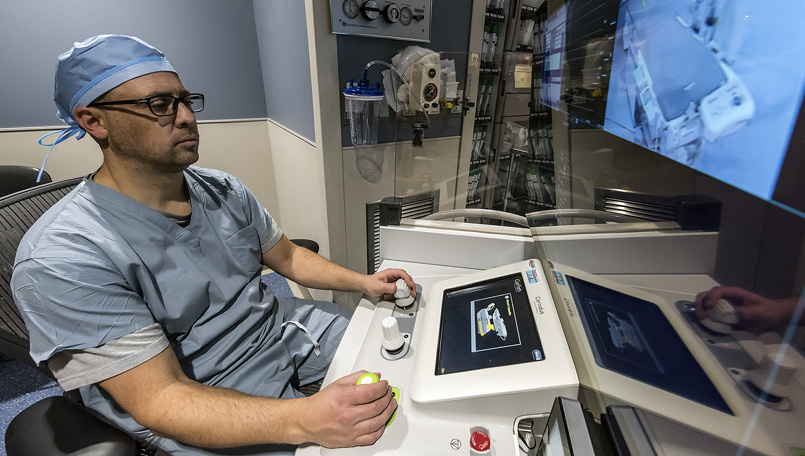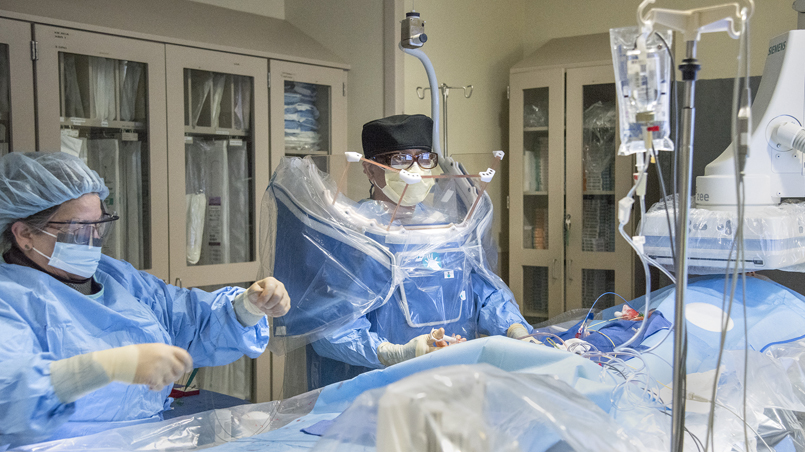Friday, February 23, 2018

More than 300 times a year, Beaumont interventional cardiologist Steve Almany, M.D., puts his own health at risk while saving the lives of others. He’s been doing it for 23 years.
Now, new technologies and equipment are helping to reduce health risks for cardiac lifesavers like Dr. Almany.
Medical profession with highest radiation exposure
Research shows that interventional cardiologists working in cardiac catheterization labs receive the highest amount of radiation exposure of any medical profession. This exposure leads to a higher risk of cataracts, thyroid disease and brain tumors, especially on the left side which is closest to the X-ray source used to image patients during procedures.
They are also at higher risk of orthopedic injuries from wearing heavy lead aprons and other equipment to protect themselves from radiation. In fact, 60 percent of interventional cardiologists report spine issues after 21 years in practice and 28 percent report hip, knee or ankle problems.
And the risk is getting worse, as procedures in the cath lab get more complex and take much longer.
Robots to the rescue in Troy
At Beaumont Hospital, Troy, a recently added CorPath Robotic System protects cardiologists while improving precision through robotic-assisted control of coronary guide wires, balloons, stents and catheters used in an angioplasty procedure. It supplements dose reduction imaging practices and a zero-gravity protection system also in place in the Troy lab.
With CorPath, the cardiologist performs the procedure from a shielded cockpit located a few feet from the patient, reducing radiation exposure more than 95 percent and eliminating the need to wear a heavy lead apron. The robotic system also allows the cardiologist to more precisely measure and select the right-sized devices to remove a heart blockage and prop the artery open with stents, improving outcomes and reducing supply waste.
Dr. Almany, Beaumont, Troy cath lab director who championed the new system, says the robot is more than about protection from radiation exposure or injury.
“Robotic-assisted technology is the future of cardiology and other medicine and Beaumont will lead the way,” he said. “Medicine is moving more and more in this direction. Telemedicine is growing and robotics provides the ability to do remote cardiac interventions for the 20 percent of the population that is not within one hour of a cath lab.”
Dr. Almany’s dream for the future of medicine is shared by Vicki and Tom Celani, local philanthropists who supported the purchase of the CorPath robot for Beaumont, Troy with a generous gift.
“It’s important to protect the caregivers who save and improve our lives,” said Tom Celani. “It’s just as important to push the boundaries of medicine to new frontiers and we were happy to partner with Beaumont to do that with our gift.”
Michael Tucciarone, M.D., the first Beaumont, Troy cardiologist to use the robot, said fine motor skills are needed to manipulate catheters, balloons and other devices using the robot’s joystick controls. “It’s easy to adapt to its use,” he said. “My goal is to get to zero lead use in the future.”
Zero-gravity in Dearborn

In the cath labs at Beaumont Hospital, Dearborn, interventional cardiologists have been using a zero-gravity protection system to reduce their radiation exposure and risk of orthopedic injuries since 2011.
It’s a walk-in, lead-lined suit suspended from the ceiling that eliminates the weight of the lead apron on the cardiologist, while providing radiation protection.
Cardiologist Chaman Sohal, M.D., has been using the system since its installation for about 60-70 percent of the 1,000 cath lab procedures he does in a year. “I would like to use it 100 percent of the time, but sometimes I move between two cath lab rooms and cannot,” he says.
His motivation for using zero gravity is prevention of back injury and better radiation protection.
“Studies have shown that radiation protection with the zero-gravity system is far greater than with regular lead,” he said. “It provides protection for your eyes, and from your shoulders all the way down to just above the ankles. “
Dose reduction and monitoring in Royal Oak
In the cath labs at Beaumont, Royal Oak, interventionalists are changing their imaging practices to reduce radiation exposure. By using slower frame rates when acquiring X-ray images, doing real-time dose monitoring and raising awareness about total radiation dose per case, the labs have seen a 30 percent reduction in the average dose of radiation per case.
Advances in cardiac care are allowing more patients with more serious disease to be treated in the cath lab. The tradeoff is that these more complex cases take longer, increasing the risk of radiation exposure and orthopedic injuries for those working in the lab.
“This makes protection of our patients and cath lab team members a growing concern,” said Simon Dixon, M.D., chair, Cardiovascular Medicine. “Safety in the cath lab has important implications for physicians, staff and patients.”
